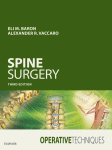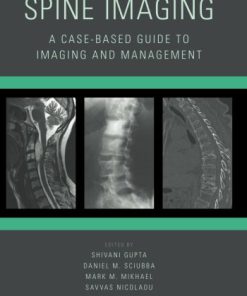Imaging in Spine Surgery 1st Edition by Jeffrey S Ross, Bernard R Bendock, Jamal McClendon ISBN 0323509290 9780323509299
$50.00 Original price was: $50.00.$25.00Current price is: $25.00.
Imaging in Spine Surgery 1st Edition by Jeffrey S Ross, Bernard R Bendock, Jamal McClendon – Ebook PDF Instant Download/Delivery: 0323509290, 9780323509299
Full download Imaging in Spine Surgery 1st Edition after payment
Product details:
ISBN 10: 0323509290
ISBN 13: 9780323509299
Author: Jeffrey S Ross, Bernard R Bendock, Jamal McClendon
Imaging in Spine Surgery tailors the highly regarded Diagnostic Imaging series templates with radiology images and color graphics to the needs of neurosurgeons, orthopedic spine surgeons, pain management and rehab (PM&R) physicians, and anesthesiologists. It provides clinical information for diagnosis and appropriate care for the patient, resulting in the perfect comprehensive text for spine surgeons.
-
Introduction to Imaging in Spine Surgery
- The evolution and importance of imaging in spinal surgery.
- Overview of the book’s objectives and target audience.
- Key principles in spine surgery: diagnosis, planning, and post-operative care.
-
Chapter 1: Overview of Spinal Anatomy
- Detailed description of spinal anatomy relevant to imaging.
- Key landmarks, structures, and their significance in surgical planning.
- The importance of accurate anatomical understanding in imaging.
-
Chapter 2: Conventional Imaging Techniques in Spine Surgery
- X-ray: Basic principles and applications.
- CT scans: When and why they are used in spinal surgery.
- MRI: Role in assessing soft tissues and intervertebral discs.
- Case studies illustrating conventional imaging in clinical practice.
-
Chapter 3: Advanced Imaging Modalities
- Functional MRI (fMRI) in assessing neurological function.
- Positron Emission Tomography (PET) and its applications in spine surgery.
- Single-photon emission computed tomography (SPECT) for bone and joint imaging.
- Fluoroscopy: Real-time imaging during surgery.
-
Chapter 4: Preoperative Imaging for Surgical Planning
- The role of imaging in diagnosis and treatment planning.
- Surgical indications for imaging: Herniated discs, scoliosis, spinal tumors, etc.
- Planning spinal fusion and deformity correction.
- 3D imaging and its impact on preoperative planning.
-
Chapter 5: Intraoperative Imaging Techniques
- Real-time imaging during spine surgery: fluoroscopy, CT, and intraoperative navigation.
- Image-guided surgery: technologies and techniques.
- Minimizing risks and complications through intraoperative imaging.
-
Chapter 6: Postoperative Imaging
- Evaluating surgical outcomes through imaging.
- Detecting complications: infection, hardware failure, nerve damage.
- Imaging for long-term follow-up: fusion success, disc degeneration.
-
Chapter 7: Image-Guided Spine Surgery
- Robotic-assisted surgery and imaging integration.
- Navigation systems in spine surgery: benefits and challenges.
- Case examples of image-guided surgeries and outcomes.
-
Chapter 8: Advanced MRI Techniques in Spinal Pathologies
- High-resolution imaging for degenerative spine disease.
- Diffusion tensor imaging (DTI) for assessing neural pathways.
- Imaging of spinal cord injuries and tumor detection.
-
Chapter 9: Emerging Technologies in Spine Imaging
- The future of imaging technologies in spine surgery.
- Augmented reality (AR) and virtual reality (VR) in surgical planning and training.
- Artificial intelligence and machine learning in spinal imaging interpretation.
- Chapter 10: Clinical Case Studies and Imaging in Practice
- Detailed case studies with imaging examples from real surgeries.
- Decision-making processes based on imaging findings.
- Lessons learned and best practices in spine surgery.
Imaging in Spine Surgery 1st Table of contents:
People also search for Imaging in Spine Surgery 1st:
imaging in spine surgery
spinal imaging techniques
dangers of spine surgery
can spine surgery be dangerous
latest technology in spine surgery
Tags:
Jeffrey S Ross,Bernard R Bendock,Jamal McClendon,Imaging,Spine Surgery
You may also like…
Medicine - Surgery













